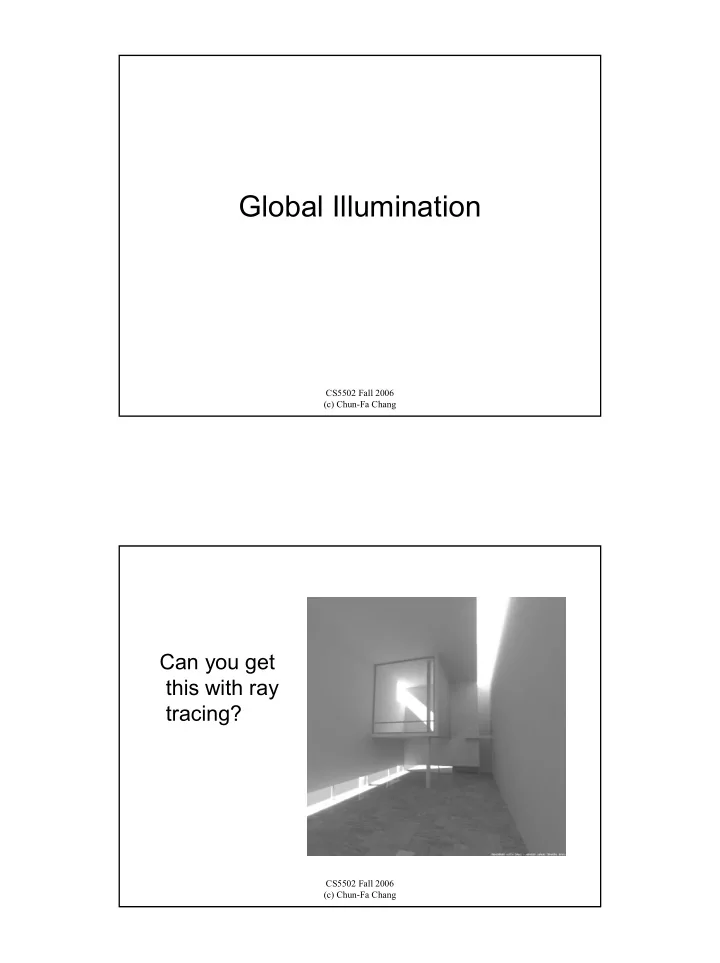

Global Illumination CS5502 Fall 2006 (c) Chun-Fa Chang Can you get this with ray tracing? CS5502 Fall 2006 (c) Chun-Fa Chang
Rendering Equation ∫ ′ ′ ′ ′ ′ ′ ′ ′ ′ ′ ′ = ε + ρ I ( x , x ) g ( x , x )[ ( x , x ) ( x , x , x ) I ( x , x ) d x ] s • g() is the “visibility” function • ρ () is related to BRDF: ρ ′ ′ ′ = ρ θ′ φ′ θ′ φ′ θ θ′ ( x , x , x ) ( , , , ) cos cos in in ref ref ref From Watt’s p.277 CS5502 Fall 2006 (c) Chun-Fa Chang How to Solve It? • We must have: – ε (): model of the light emitted – ρ (): BRDF for each surface – g(): method to evaluate visibility • Integral evaluation ! Monte Carlo • Recursive equation ! Ray Tracing • The problem is view independent CS5502 Fall 2006 (c) Chun-Fa Chang
Ray Tracing Revisited • The reflected intensity (or color) at a surface point is computed by: – Local reflection model (no interaction with other objects): ambient, diffuse, and specular. – Global model: perfect reflection and refraction. • What if we spawn many reflected rays? CS5502 Fall 2006 (c) Chun-Fa Chang Global Illumination Algorithms • Radiosity (topic of the next lecture). • Distributed Ray Tracing. • RADIANCE • Photon Map CS5502 Fall 2006 (c) Chun-Fa Chang
Distributed Ray Tracing • Distribute a group of rays at a hit point to sample the “reflection lobe” (similar to a 2D slice of BRDF). • May also distribute rays along camera aperture, time, and pixel region to produce effects of depth of fields, motion blur, and anti- aliasing. CS5502 Fall 2006 (c) Chun-Fa Chang Why Distributed Ray Tracing? • Anti-Aliasing • Features – Gloss (fuzzy reflections) – Fuzzy translucency – Penumbras (soft shadows) – Depth of field – Motion blur CS5502 Fall 2006 (c) Chun-Fa Chang
Anti-Aliasing • Supersampling • Jittering – Stochastic Method 6 10 2 13 3 14 12 8 15 0 7 11 5 9 4 1 CS5502 Fall 2006 eye (c) Chun-Fa Chang Gloss normal normal R R I I surface surface CS5502 Fall 2006 (c) Chun-Fa Chang
Fuzzy Reflection 64 rays, 956 seconds 4 rays, 37 seconds CS5502 Fall 2006 (c) Chun-Fa Chang Translucent normal normal I I surface surface T T CS5502 Fall 2006 (c) Chun-Fa Chang
4 rays 16 rays CS5502 Fall 2006 (c) Chun-Fa Chang Penumbra (Soft Shadow) eye eye surface surface Hard Shadow Soft Shadow CS5502 Fall 2006 (c) Chun-Fa Chang
Soft shadow - cube Without penumbra With penumbra CS5502 Fall 2006 (c) Chun-Fa Chang Depth of Field CS5502 Fall 2006 (c) Chun-Fa Chang
Depth of Field CS5502 Fall 2006 (c) Chun-Fa Chang Depth of Field F-Stop = 5.8 F-Stop = 2.8 CS5502 Fall 2006 (c) Chun-Fa Chang
Depth of Field Focal Distance = 13 Focal Distance = 11 CS5502 Fall 2006 (c) Chun-Fa Chang Motion Blur • Sampling in time • Each element in the cell stands for a time slice • Jitter time slice to the current time • Move object via the current time slice 6 10 2 13 Current time = Time Slice + Jitter Time 3 14 12 8 e.g. time slice at left-upper = 6 + rand() 15 0 7 11 5 9 4 1 CS5502 Fall 2006 (c) Chun-Fa Chang
Motion Blur CS5502 Fall 2006 (c) Chun-Fa Chang Typical Distributed Ray Path CS5502 Fall 2006 (c) Chun-Fa Chang
Recommend
More recommend